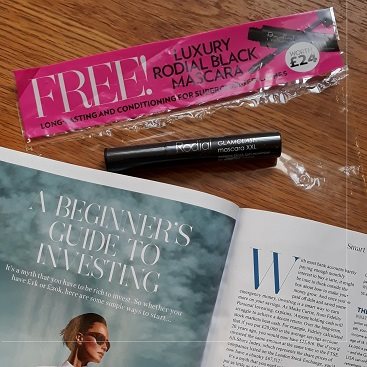This post may contain affiliate links which means that if you click through to a product or service and then buy it, I receive a small commission. There is no additional charge to you.
Welcome to the first profile in my ‘Investing : a woman’s perspective’ series designed to get ordinary women interested in investing.
Last week I wrote about my frustrations with how men and women are spoken to about money in the media. I hope that by sharing stories from ordinary women across various walks of life about their investments, I can plant the seed to encourage other women to learn more.
 Faith Archer is my first woman investor in the series and I couldn’t think of anyone better to kick off the series. Like me, Faith is passionate about encouraging other, and particularly women, to learn how to invest. You may have seen her Beginner’s Guide to investing article in this month’s Red magazine. Here she shares her own investing story.
Faith Archer is my first woman investor in the series and I couldn’t think of anyone better to kick off the series. Like me, Faith is passionate about encouraging other, and particularly women, to learn how to invest. You may have seen her Beginner’s Guide to investing article in this month’s Red magazine. Here she shares her own investing story.
Firstly, tell us about yourself?
I’m Faith, a married mother of two children at primary school. We made the big leap from London to Suffolk nearly four years ago, and I blog at Much More With Less about moving to the country, living on less and making the most of it.
I also write about money as a freelance journalist, previously deputy personal finance editor at The Daily Telegraph.

What investments do you have? What are your goals for your investments?
Like a lot of people, my first step into investing was my pension. My first job didn’t offer a pension, and I’m glad I set up a private pension and continued scraping together contributions even when I was on maternity leave. It’s a stakeholder pension with Legal & General and I keep meaning to check if I should move it elsewhere. In addition, I have a workplace pension from my time at the Telegraph, topped up with additional voluntary contributions.
I also invested in some investment trusts, where I pay fees so a fund manager picks and chooses what to invest in, hoping to beat the market, plus some money with Vanguard, which is based on index tracker funds that just try to follow the market.
My goal is for us to have a comfortable retirement, funded by a mix of ISAs, pension, rental property and my writing. The state pension is so low, I don’t fancy choosing between heating and eating in later life.
How long have you been investing for? What made you start when you did?
Despite writing about investments for many years, I only finally got fed up with the rubbish rates on my cash individual savings accounts (ISAs) back in 2015. I’d spent too long writing warnings about “don’t invest money you can’t afford to lose” and “investments can go down as well as up”. Also, I knew investing was only really suitable for money you can tie up for 5 years or more, and I was cautious about investing money we might need for emergencies.
The lightbulb moment was realising I’d earmarked the ISA money for retirement – a good couple of decades away. Investing makes much more sense over a longer time, because historically, shares have much more chance of beating cash.
How did you decide what to invest in/research your investment(s)?
I was keen to invest in funds with a long track record. Yes, past performance is no guarantee for the future, as all the risk warnings say, but I prefer to invest with funds and companies that have survived and thrived in different market conditions. The choice of shares and funds can seem overwhelming, but I knew about the ‘dividend hero’ investment trusts that have increased dividend payments every year for more than 20 years, so I asked an independent financial adviser to look at the list to see if he liked any of them. (list here)
He suggested 3 dividend heroes (City of London, Scottish Mortgage and Temple Bar) and added another investment trust (Finsbury Growth and Income). I invested just over £28,600 back in September 2015, and it’s now worth nearly £40,600. That’s more than 40% up! I can’t hope to earn anywhere near that much year in, year out, but it’s off to a good start.
Since then, I’ve also invested some money in the Vanguard LifeStrategy 80% fund. Vanguard is the second biggest asset manager in the world and has super cheap fees that will eat away less of my money. I like the LifeStrategy funds because they spread my money right across the world, and do all the hard work of rejigging the balance between shares and bonds for me.
https://www.instagram.com/p/Bfayc8-hM8h/?taken-by=moneywhisperer_
Has your attitude to investing always been the same or changed through your life?
Definitely changed. I stuck to property and never thought investing in the stockmarket was for me – who wants to lose money? But research by Barclays back to the 19th century shows there’s a 99% chance of shares beating cash when investing for as long as 18 years. I’ll take those odds.
I asked Fidelity Personal Investing to crunch some numbers for me, and over the last 40 years, the FTSE All Share has returned an average of 11.52% a year. That’s way better than I could earn in cash! But you do need to be able to sleep at night knowing it won’t return 11.52% every year – some years might be way more, some years you might end up with a smaller balance than the start of the year.
You only actually lose money if you sell when prices are lower than when you bought your investments, and long term, the stock market trends upwards.
If you have children, do you invest for them and if so, in what?
Yes, both children have Child Trust Funds (previous version of Junior ISAs). Again, they’re in investment trusts: Foreign & Colonial and F&C Global Smaller Companies. My 10-year-old daughter’s CTF is now worth three times what we have paid into it.
What advice would you give to someone who says ‘I don’t know where to start’….
Investing can seem very scary, with complicated jargon and an overwhelming choice of companies and funds. But you don’t need to know everything to get started. Better to start soon, even if you start small, and learn as you go along.
With a lot of platforms you can open a stocks and shares ISA and pay in as little as £25 to £100 a month. Have a play on the websites of some of the robo-advisers, like Nutmeg, Wealthify or Moola. You can try out their questionnaires to find out how much risk you can cope with, even if you end up investing elsewhere. Whatever you choose, keep an eye on the costs involved, because they really add up over the decades! You’ll need to consider costs of both the website or platform you use to invest, and the investments you buy. I aim to keep costs between about 0.5% and 1% a year all in.
I’ve written a couple of posts for people who are thinking about investing but have never tried it before:
I’m also proud to have written some guest posts for the new Steps to Investing website, which provides a step-by-step guide to help people making their first investment. It has a whole range of videos, blogs and tools to help guide people through the maze of jargon. It’s powered by Janus Henderson Investors, who’ve been in business since 1934.
Plus, there’s even a FREE stepstoinvesting.com event in London from 6.15pm on Wednesday 25 April at the Southbank Centre, with the chance to grab a glass of wine and hear from like-minded newbie investors, without a suit or a salesperson in sight. Sign up here.

